Marisa McClellan's Blog, page 29
February 3, 2018
February Sponsors: Cuppow, Fillmore Container, EcoJarz, Mason Jar Lifestyle, and CanningCrafts
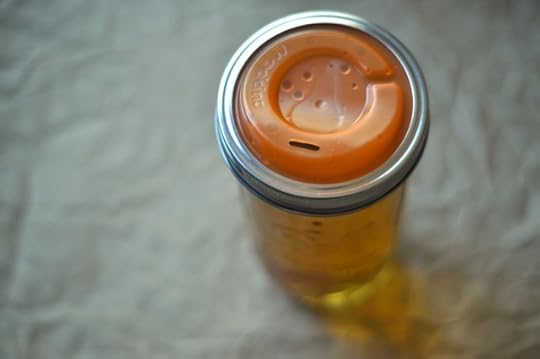
Happy February, dear readers! I’m deep in the drafting process for my next book, so it’s been quiet around these parts lately. However, it’s the start of the month and no amount of writing frenzy is going to keep me from thanking the businesses that help make this site possible. Please do show them that you appreciate their support with your time and attention!
In the top spot are our friends at Cuppow. They are the creators of the original mason jar travel mug topper and the BNTO, a small plastic cup that transforms a canning jar into a snack or lunch box. One of my goals for the new year is to drink 3 quarts of water a day, and my Cuppow lid helps me stick to that goal without spilling all over the place.
Lancaster, PA-based and family-owned Fillmore Container are next! They sell all manner of canning jars, lids, and other preservation gear. If you’re looking for a good seasonal recipe, try their recipe for Rosemary Grapefruit Jam.
Our friends over at EcoJarz are another stalwart sponsor. They make an array of products designed to fit on top of mason jars, including cheese graters, coffee brewers, and stainless steel storage lids. If you’re hoping to get into fermentation this year, their fermenting kit is a useful and affordable option!
Mason Jar Lifestyle is a one-stop shopping site for all the jar lovers out there. They sell all manner of mason jar accessories and adaptors. If you’re in the market for lids, straws, sprouting lids, fermentation weights, airlocks, tea light converters, cozies, and more, make sure to check them out. I particularly love their one-piece stainless steel lids, paired with leakproof silicone liners. They make it easy to transport soup to work without spilling a drop!
Next up is CanningCrafts. Shop owner Alison sells an array of ready made and custom mason jar labels for all your various preserves, syrups, and backyard honey. Make sure to subscribe to the CanningCrafts newsletter, because you’ll get a 10% off coupon code!
And if your company, shop, or family business is interested in reaching the food-loving and engaged Food in Jars audience, you can find more details here. Leave a comment on this post or drop me a note to learn more!
Related Posts:
January Sponsors: Cuppow, Fillmore Container, EcoJarz, Mason Jar Lifestyle, and CanningCrafts
December Sponsors: Cuppow, Fillmore Container, EcoJarz, Mason Jar Lifestyle, CanningCrafts, and Mrs. Wages
November Sponsors: Cuppow, Fillmore Container, EcoJarz, Mason Jar Lifestyle, CanningCrafts, and Mrs. Wages
January 23, 2018
Meyer Lemon Ginger Marmalade + Giveaway
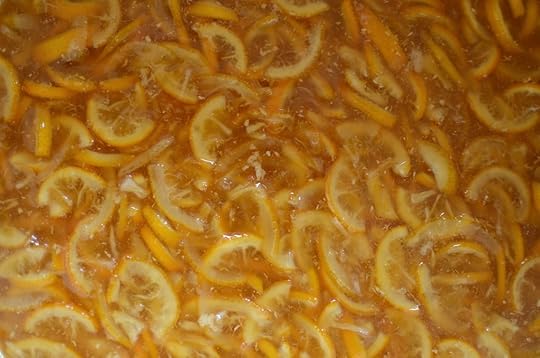
One of the things that happens when I get close to a book deadline is that my life gets whittled down to the bare essentials. I work, I cook, I exercise, and I sleep. Things get very messy in my apartment, save for the moments of intense procrastination cleaning (the seams and edges of of my kitchen faucet have never sparkled so brightly).
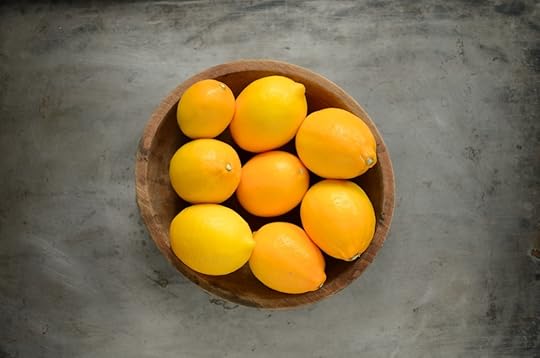
Because the book I’m working on is not dedicated to preserving, my canning practice has really fallen flat in recent days. In fact, until I made this marmalade, it had been nearly a month since I’d canned anything. That’s the longest I’ve gone without firing up the water bath in the last decade.
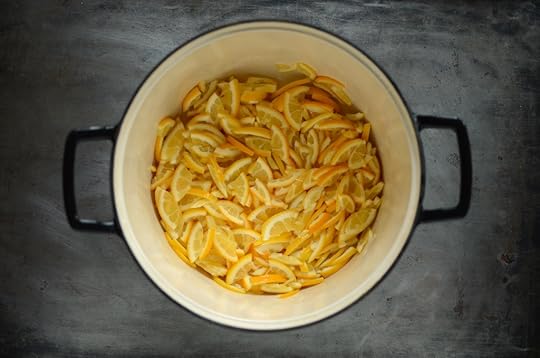
However, no amount of book work is going to keep me away from Meyer lemon season. They’re only available for a short time each winter and since my order arrived from Lemon Ladies Orchard, I’ve been carving out little pockets of time to salt, dry, and preserve all that sunny lemon goodness.
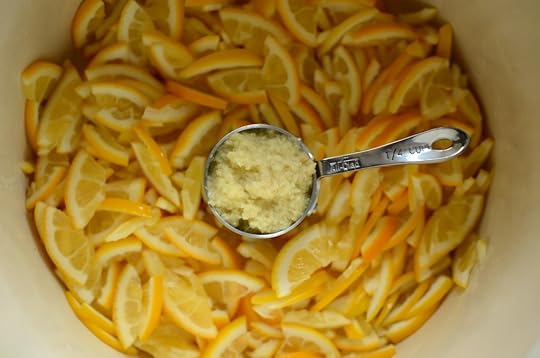
For this batch of marmalade, I chose to boost the flavor with three ounces of finely grated ginger. I sometimes opt to add ginger flavor by juicing the ginger root, but because I’m short on time these days, I went for the quickest option that didn’t require cleaning another appliance.
I don’t mind having small bits of ginger flesh scattered throughout my marmalade. However, if you need the jelly component of your marmalade to be crystal clear, I suggest you make or buy ginger juice and use approximately 1/4 cup instead.
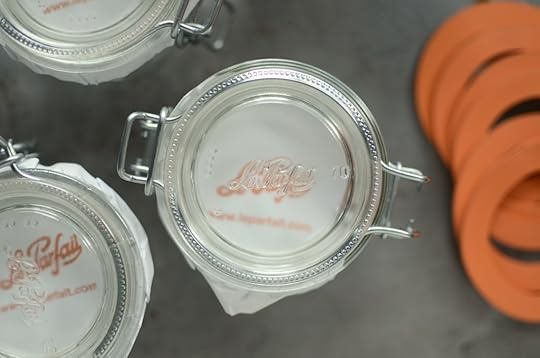
The other thing that got me excited to make this batch of marmalade was the fact that I had these snazzy Le Parfait 200 ml terrines in which to can it. I really enjoy using jars from Le Parfait because of their heft and sturdiness. They also make me feel instantly transported to Europe for far less money than a plane ticket.
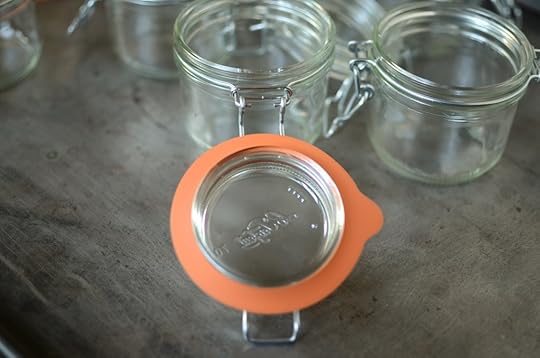
Assembling Le Parfait jars for use is easy. Once you’ve given both the jars and the rubber gaskets a good washing with warm, soapy water, you fit the gaskets onto the lids, making sure that the easy-open tab is pointing off to the side of the jar (so that it doesn’t get in the way of the hinge or the clamp).
I warm them in my canning pot, and while filling take care to leave a little extra headspace, to ensure that there plenty of space for the lid to close.
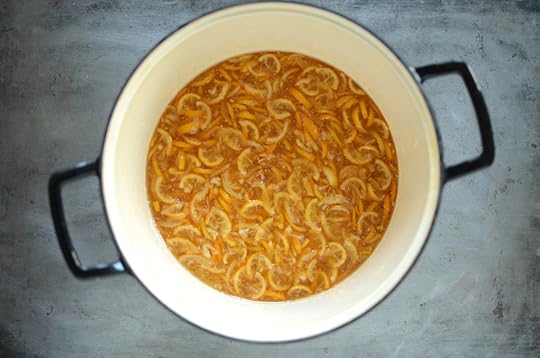
I’ve done a lot of writing about the art of making marmalade over the years, so I’m not going to rehash all those details here. If you’re coming to this post without ever having made marmalade before, I suggest you read these three posts before digging in.
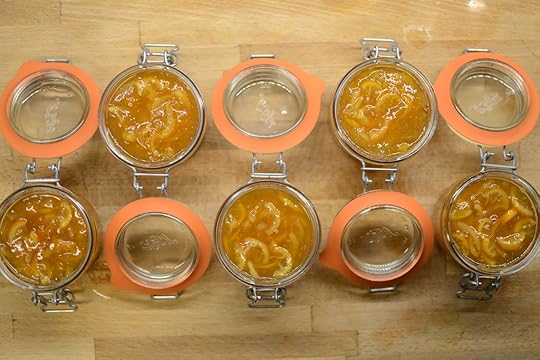
Now, here is the fun part. I’ve partnered with my friends at Lemon Ladies Orchard and Le Parfait to offer a giveaway in conjunction with this post. Three lucky winners will get a Meyer lemon gift bag from Karen at Lemon Ladies containing three pounds of fruit and an eight-pack of 200 ml Le Parfait terrines (they hold about 7 ounces, just a touch less than a conventional half pint jar).
The giveaway runs until Sunday, February 4, 2018 at 12 noon Eastern time. Please use the widget below to enter!
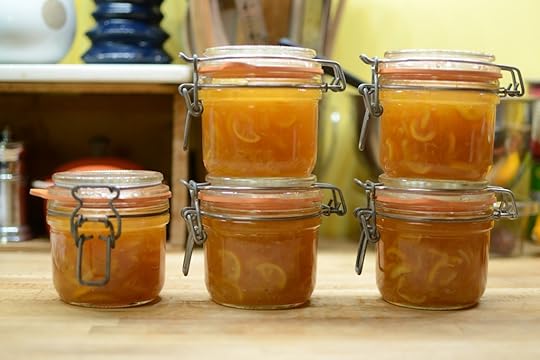
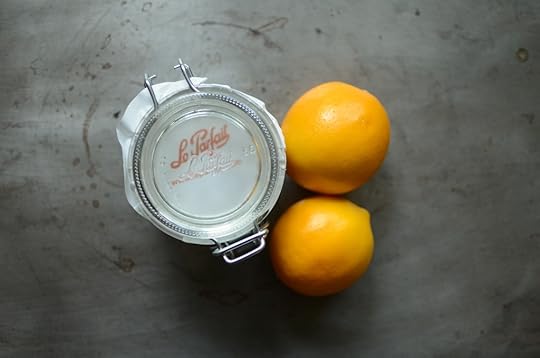
Print
Meyer Lemon Ginger Marmalade
Yield: makes 4-5 half pints
Ingredients
2 pounds Meyer lemons (preferably organic)
4 cups water
4 cups granulated sugar
1/4 cup finely grated ginger
Instructions
Wash the lemons. Cut away both the stem and blossom ends and slice each lemon into quarters. Cut away the thin strips of white pith from the interior of the wedges and use the tip of your knife to poke out the seeds. Cut each quarter into thin slices from top to bottom.
Once all the lemons are sliced, place them in a bowl (along with any of their liquid that you were able to capture) and add 4 cups of water. Let the sliced lemons soak overnight.
The next day, combine the lemons, soaking water, sugar, ginger in a large, non-reactive pan.
Place the pan on the stove and set the burner to high.
Bring the contents of the pot to a boil and cook, stirring regularly, until the contents of the pot have reduce by at least half and is starting to shape up into marmalade. You may need to reduce the heat as cooking progresses so that you maintain a low boil without scorching the bottom of the pot.
While the marmalade cooks, prepare a boiling water bath canner and 5 half pints.
Test for set using both the plate and temperature tests (required temp is 220F).
When you deem that the marmalade is done, remove the pot from the heat.
Funnel the finished marmalade into the prepared jars, leaving 1/2 inch headspace.
Wipe the rims, apply the lids and rings, and process in a boiling water bath canner for 10 minutes.
When the time is up, remove the jars and set them on a folded kitchen towel to cool. When the jars have cooled enough that you can comfortably handle them, check the seals. Sealed jars can be stored at room temperature for up to a year. Any unsealed jars should be refrigerated and used promptly.
4.21
http://foodinjars.com/2018/01/meyer-lemon-ginger-marmalade/
Disclosure: Both Lemon Ladies Orchard and Le Parfait are providing the giveaway items at no cost to me. Le Parfait also provided the jars you see pictured here at no cost to me. No additional funds were provided. I paid for my lemons.
Related Posts:
Giveaway: Meyer Lemons from Lemon Ladies Orchard
The Sur La Table Preserving Box + Giveaway
Marshall’s Haute Sauce Canning Kit – Instagram Giveaway
January 18, 2018
Resolution Recipes – An eBook from Local Mouthful
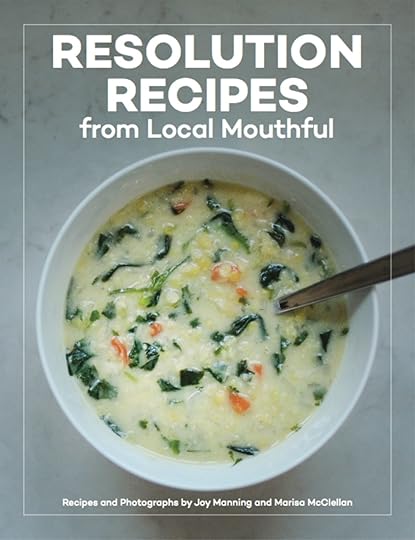
Hello friends! I’m so sorry that it’s been so quiet around these parts. I’m deep in the creation stage for my next book and it’s been really challenging to shift my focus from the book and back to creating content for this site. I’m going to try to do a bit better, but inevitably things are going to be a little quieter around here until I get this manuscript turned in.
However, I do have something fun to share. As some of you may know, I co-host a podcast called Local Mouthful with my longtime friend and fellow food writer, Joy Manning. We’ve been making the show for a little over two years now and have had it in the backs of our heads for awhile to make a downloadable ebook.
Back in the fall, we decided to tackle that goal and so, with the help of a very talented designer, created a twelve recipe book that we’ve called Resolution Recipes. The name is inspired by turn of the year and the fact that many of us are moved to set food-related goals in January. We wanted to create a collection of recipes that could help you meal plan, meal prep, cook more, and increase your intake of plant based foods (we figured these were some common food resolutions).
The ebook includes Joy’s Instant Pot hummus, my favorite red lentil soup (pack it up in mason jars for a week’s worth of easy lunches!), a tasty tofu ricotta, and a blender vinaigrette made mostly from Sungold tomatoes (having some in the fridge will make you crave salad). We’re selling the book for $5 and if you’re interested, you can buy it here.
Related Posts:
Hear Me Each Week on Local Mouthful
Local Mouthful’s 25th Episode
Updates from the West Coast Book Tour
January 11, 2018
Preserves in Action: Kimchi Noodle Soup
Need something spicy, flavorful, and warming? Alex Jones is here with a recipe for a tasty batch of soup that will help you make good use of that jar of kimchi you’ve got tucked in the back of the fridge! Yum! -Marisa
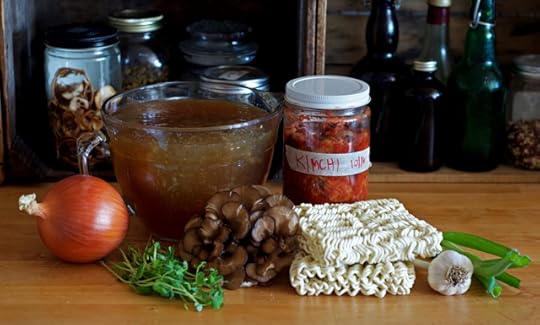
Throughout my preserving life, I’ve realized that I use some things all the time — pressure-canned tomatoes, stock and beans, dried herbs and Meyer lemon slices, frozen peak-season fruit. And others, like high-sugar jams, I don’t use much of at all.
As I go along each season, I try to learn from what I end up giving away or not enjoying so that I can maximize my food dollars, avoid waste, and devote space in my fridge and pantry to items I’ll actually eat.
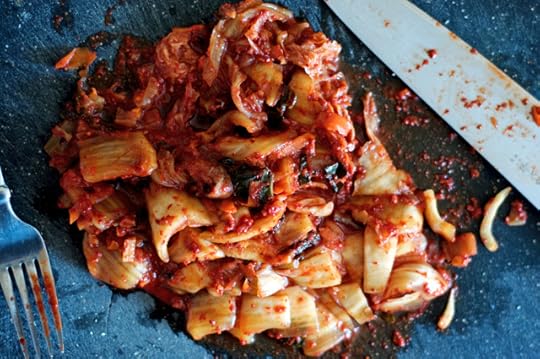
When I found myself with two huge napa cabbages in my fridge two falls ago, I made a massive batch of kimchi (using the excellent recipe from Maangchi’s Real Korean Cooking). After giving several jars away at the Philly Food Swap, I still had a gallon left. And while I’ve added it to rice bowls and eaten it on the side with scrambled eggs, two big jars still sit in the back corner of my fridge.
One of my intentions for the new year is tokeep my fridge slightly less jam-packed than it usually is — which includes using up good preserves that I sometimes ignore. Luckily, there’s an excellent Korean dish — kimchi-guk — that turns this pungent condiment into a delicious, warming soup.
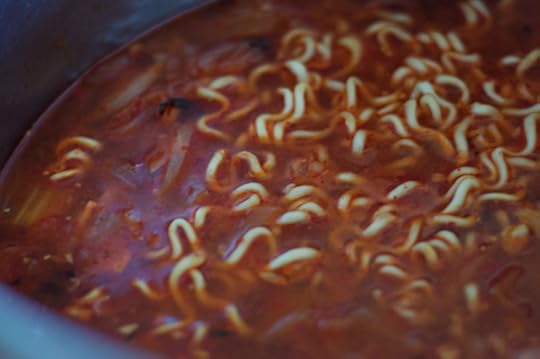
Maangchi’s method is pretty simple (and delicious). But I wanted to see if I could find a kimchi soup recipe that’s even easier and a little more pantry-friendly.
Luckily, Serious Eats thought of this already, with their recipe for kimchi ramen. Using their recipe as a roadmap, I tweaked the proportions (boosted the aromatics and umami and cut the quantity of stock) made the noodle step even easier for a recipe that’s as foolproof as it is delicious.

And if your fridge is really empty, you could make this with just the broth, kimchi, onion and garlic, and noodles — just salt to taste and maybe add some takeout soy sauce packets from the kitchen drawer (hey, I won’t judge) and eat it without the garnish — but it’s so much prettier (and tastier) with a little greenery and some protein on top.
Do you keep a jar of kimchi in your fridge? What are your favorite ways to enjoy this peppery, funky ferment?
Print
Kimchi Noodle Soup
Ingredients
Adapted from Serious Eats
1 tablespoon neutral oil (safflower, grapeseed, canola, vegetable)
1 onion, sliced
4 cloves of garlic, sliced
2 inches of fresh ginger, chopped fine
1 1/2 cups kimchi (chop roughly if needed) and kimchi juice
2 quarts chicken or vegetable stock (ideally a bone broth that gets good and gelatinous in the fridge)
3 tablespoons red or white miso paste
3 tablespoons soy sauce
2 blocks instant ramen noodles
Toppings: scallions, firm silken tofu, soft-boiled egg, pea shoots, finely sliced greens, sautéed mushrooms (like maitake, shiitake, oyster, or a combination)
Instructions
Heat neutral oil over medium-high in a large soup pot. If using mushrooms, sautée for several minutes until cooked. Remove mushrooms and set aside.
Add another drizzle of oil if necessary. Add onion and cook till translucent. Add garlic and ginger and cook for a few more minutes.
Add stock, kimchi and kimchi juice to the pot. Mix the miso in a small bowl with a ladleful of stock, then add it to the pot with the soy sauce, then bring to a simmer. Season to taste with salt.
Add noodle blocks, then cover the pot and cook for a few minutes. When the noodles are tender, stir to break them up and remove the pot from the heat.
Ladle the soup into bowls and garnish with toppings. Serve immediately.
4.21
http://foodinjars.com/2018/01/preserves-in-action-kimchi-noodle-soup/
Related Posts:
Preserves in Action: Open Faced Kimchi & Egg Sandwich
How to Make Fromage Fort
Mastery Challenge: Apple-Quince Fruit Cheese
January 9, 2018
Bring Your Family Back to the Table
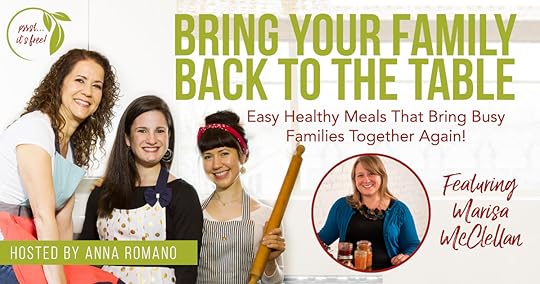
Hey friends! I’m deep in the draft for my next book, so I don’t have a fresh recipe for you today. Happily, I still have some fun news. Recently, Anna Romano of Healthy Cooking Daily interviewed me for her series, called Bring Your Family Back to the Table.
Anna is offering 21 interviews with cooks, health coaches, nutritionists, moms, and bloggers (including me!) to show you how to meet some of the daily challenges of creating healthy meals and connecting with family. The interviews will deal with topics like:
How to bring mindfulness back into eating
How to save time in the kitchen to get dinner on the table faster
Homesteading tips
Gadget recommendations
How to ensure family meals are both healthy and delicious
How to cook for multiple dietary needs
Learn about using the Slow Cooker/Instant Pot to simplify weeknight meals
Menu Planning tips and suggestions
In our conversation, Anna and I talked about canning and preserving and how having a robust homemade pantry can lead to good eating all year round.
The interviews go live on January 18, 2018. If this sounds like something you’d like to experience, click here to register.
Related Posts:
Check the recipe index for more tasty preserves!
January 5, 2018
January Sponsors: Cuppow, Fillmore Container, EcoJarz, Mason Jar Lifestyle, and CanningCrafts
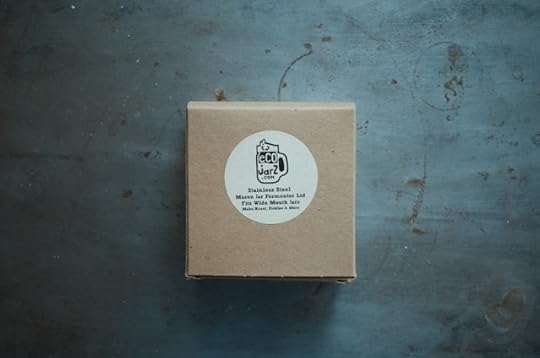
Happy new year, dear readers! It’s the start of the month, which means it’s time to thank the businesses that help make this site possible. Please do show them that you appreciate their support with your time and attention!
In the top spot are our friends at Cuppow. They are the creators of the original mason jar travel mug topper and the BNTO, a small plastic cup that transforms a canning jar into a snack or lunch box. If your goal this year is to reduce your use of disposable cups, get yourself a five-pack of Cuppow lids so that there’s always a clean one waiting for you!
Lancaster, PA-based and family-owned Fillmore Container are next! They sell all manner of canning jars, lids, and other preservation gear. Right now, they’ve got my recipe for Winter Fruit Mostarda up on their blog. It’s one of my favorite preserves and is such a good way to put up storage apples and pears.
Our friends over at EcoJarz are another stalwart sponsor. They make an array of products designed to fit on top of mason jars, including cheese graters, coffee brewers, and stainless steel storage lids. If you’re hoping to get into fermentation this year, their fermenting kit is a useful and affordable option!
Mason Jar Lifestyle is a one-stop shopping site for all the jar lovers out there. They sell all manner of mason jar accessories and adaptors. If you’re in the market for lids, straws, sprouting lids, fermentation weights, airlocks, tea light converters, cozies, and more, make sure to check them out. I particularly love their one-piece stainless steel lids, paired with leakproof silicone liners. They make it easy to transport soup to work without spilling a drop!
Next up is CanningCrafts. Shop owner Alison sells an array of ready made and custom mason jar labels for all your various preserves, syrups, and backyard honey. Make sure to subscribe to the CanningCrafts newsletter, because you’ll be getting a special treat from me in an upcoming edition!
And if your company, shop, or family business is interested in reaching the food-loving and engaged Food in Jars audience, you can find more details here. Leave a comment on this post or drop me a note to learn more!
Related Posts:
December Sponsors: Cuppow, Fillmore Container, EcoJarz, Mason Jar Lifestyle, CanningCrafts, and Mrs. Wages
November Sponsors: Cuppow, Fillmore Container, EcoJarz, Mason Jar Lifestyle, CanningCrafts, and Mrs. Wages
October Sponsors: Cuppow, Fillmore Container, EcoJarz, Mason Jar Lifestyle, CanningCrafts, and Mrs. Wages
January 4, 2018
The 2017 Class of Canning, Preserving, and Culinary DIY Books
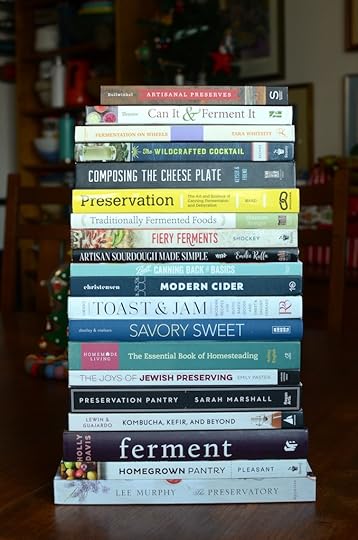
It is time for my annual round-up of all the canning, pickling, and preserving (or preserving-adjacent) books that came out last year (I typically try to get this post up before the holidays, but I could not make it happen this time). Not all of these are traditional canning books, but all have a high enough number of jams, pickles, infusions, decoctions, and condiments that they deserve placement on the list.
Please forgive me if I missed a book! I do my best to keep track of the category, but occasionally a preserving book or two slips by me. If you feel like something was overlooked, please do let me know!
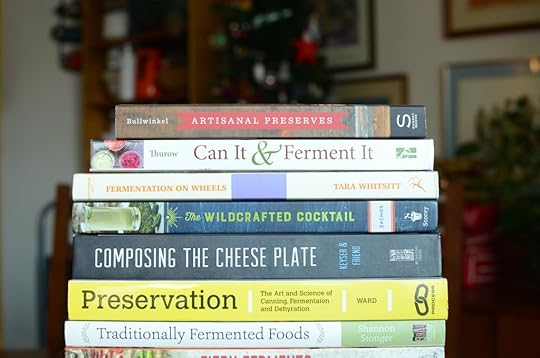
Artisanal Preserves – This is a beautifully packaged reissue of a classic preserving book by storied cooking teacher Madelaine Bullwinkel. It features traditional jams, jams without added sugar, jellies, marmalades, preserves, breads and muffins, and desserts. Amazon | Powell’s
Can It & Ferment It – Written by long-time canner Stephanie Thurow, this book is organized by season and offers recipes for both canned and fermented items. It focuses primarily on pickles, salsa, and relishes, so it’s a good one for folks who prefer the salty and tangy side of things. Amazon | Powell’s
Fermentation on Wheels – Part cookbook and part travelogue, this is the story of Tara Whitsitt’s years spent traveling in a school bus, sharing her love and knowledge of fermentation. It’s a delightful tale and the recipes can’t be beat. Amazon | Powell’s
The Wildcrafted Cocktail – Written by foraging expert Ellen Zachos, this book offers up a wide array of garnishes, syrups, infusions, juices, and bitters made from ingredients you can often find in your own backyard. There’s a whole lot of inspiration here for anyone looking to take their home bar program from good to great. Amazon | Powell’s
Composing the Cheese Plate – The thing I always love about cheese plate books is that they’re often preserving books in disguise. This one, written by cheese evangelist Brian Keyser and pastry chef and condiment maker Leigh Friend, is bursting with an array of bright, creative, and unusual things to spread, smear, and dollop. Amazon | Powell’s
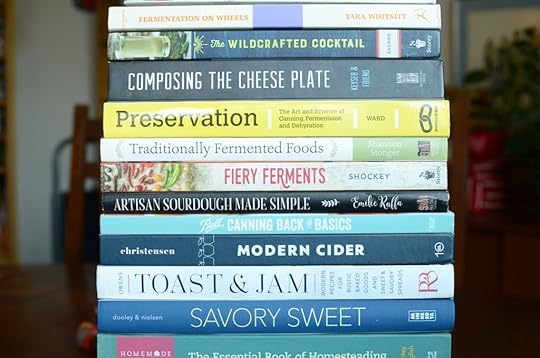
Preservation – For canners who like a goodly dose of science with their jams and pickles, there is no better book than Christina Ward’s comprehensive volume. She is a master food preserver who digs into the hows and whys of water activity, pectin, and the boiling water bath process. Amazon | Powell’s
Traditionally Fermented Foods – By Shannon Stonger, this book focuses on a wide spectrum of classic fermented foods. Shannon writes the blog Nourishing Days from her family’s small Texas farm and her book feels very much like an extension of her site. It’s friendly, helpful, and comes from a place of deep experience and expertise. Amazon | Powell’s
Fiery Ferments – The second book from seasoned pickle makers Kristen and Christopher Shockey, this one focuses on building pickles, sauces, and condiments that walk on the spicy side. You’ll find an in-depth sections on the ingredients that bring the heat like ginger, galangal, turmeric, peppercorns, and chiles. It’s so good for anyone longing to bring some serious zip to their fermentation. Amazon | Powell’s
Artisan Sourdough Made Simple – I’ve been an on and off sourdough baker for years now and this book by Emilie Raffa (she blogs at The Clever Carrot) is one of the best introductory books on the subject that I’ve seen. It also features a short but mighty section of dips, spreads, and jams towards the back that are good whether you’ve baked your own loaf or you’re picking one up at the market. Amazon | Powell’s
Ball Canning Back to Basics – This book was written by the Ball Canning test kitchen team and offers all the reliability of Ball recipes, with gorgeous step-by-step photography. If someone asked me to recommend an introductory canning book for a visual learner, this would be the very first volume I would suggest. Amazon | Powell’s
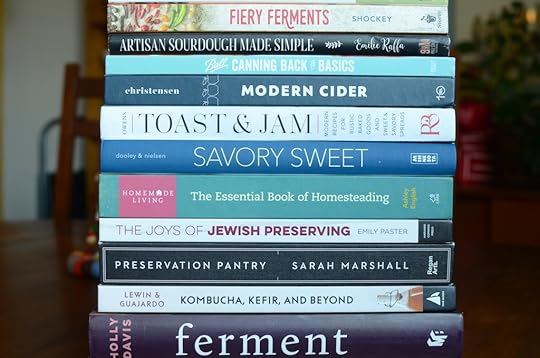
Modern Cider – With this book, Emma Christensen claims her crown as undisputed queen of small batch home brewing. It’s the perfect guide for anyone who has been intrigued by boozy fermentation but doesn’t drink beer. Amazon | Powell’s
Toast & Jam – Looking for a book that will get you stirring up tasty preserves AND help you discover a world of naturally leavened breads on which to spread them? Look no further than this gorgeous book by Sarah Owens (she also posts really amazing Instagram stories about her various ferments, preserves, and bakes). Amazon | Powell’s
Savory Sweet – This book, by Beth Dooley and Mette Nielsen, focuses on simple, approachable preserving with a northern sensibility. Organized by ingredient, all the recipes are small batch preserves that are low in sugar, are bright and zippy on the tongue, and can be stashed in the fridge or freezer rather than needing to be processed in a water bath canner. Amazon | Powell’s
The Essential Book of Homesteading – This hefty book gathers up all four of the books that Ashley English wrote for her Homemade Living series and tucks them into a single volume. It contains detailed info on canning, home dairy, keeping chickens, and raising bees. Amazon | Powell’s
The Joys of Jewish Preserving – Written by Food Swap! author Emily Paster, this lovely book celebrates the many aspects of traditional Jewish jams, pickles, fruit butters, and spreads. From your classic fermented deli pickle to lemon curd designed to use up extra egg yolks (common around Passover!), there’s a wealth of goodness here. Amazon | Powell’s
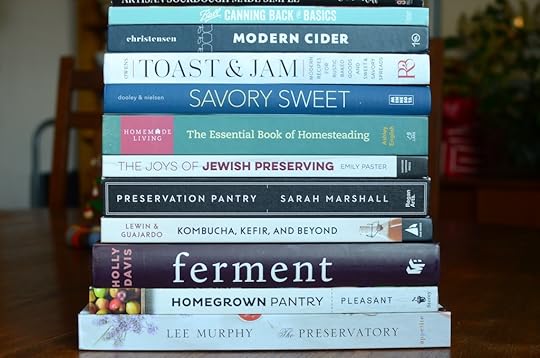
Preservation Pantry – Written by Sarah Marshall, the kitchen genius behind Marshall’s Haute Sauces, this is like an encyclopedia for canners. Organized by ingredient (much like Savory Sweet), this book goes well beyond the sauces that Sarah makes and sells. She digs into 24 different fruits and vegetables, and shows you how to preserve all that goodness without a smidgen of waste. Amazon | Powell’s
Kombucha, Kefir, and Beyond -This book, written by Alex Lewin and Raquel Guajardo, offers an array of approaches to fermented drinks. In 13 wide-ranging chapters, they hit on everything from kombucha to fermented cocktails. There are sodas, vegetable drinks, and even traditional Mexican fermented drinks that date back to the pre-Hispanic era. The recipes are relatively simple, intriguing, and entirely approachable. Amazon | Powell’s
Ferment – Written by Australian chef Holly Davis, this book offers up some serious fermentation knowledge (Sandor Katz wrote the introduction). For those who are looking to deepen their fermentation practice, I highly recommend it. Amazon
Homegrown Pantry -So often, people ask me if I grow what I can and if I could give them gardening advice. I always disappoint them when I confess that I’m not a gardener. Happily, this book by Barbara Pleasant, is designed to help you choose the best varieties to plant, determine how much you’ll need to grow, and the best ways to preserve the fruits, vegetables, and herbs that are the result of your hard work. Amazon | Powell’s
The Preservatory -This gorgeous, hard cover book by Lee Murphy contains 80 sophisticated, unusual, and intriguing recipes. They’re broken down so half are preserves and the balance is a collection of dishes, drinks, and baked goods that you can make with the contents of those glowing jars. Amazon | Powell’s
That wraps up this year’s class of preserving books. You can find previous years here: 2016 | 2015 | 2014
Disclosure: Some of the books pictured here were received as review copies. Others I bought. The Amazon links are affiliate (so I make a few pennies if you click over and buy). The Powell’s links are not.
Related Posts:
Cookbooks: Composing the Cheese Plate
A Trio of Cookbooks – Smorgasbord, The Simple Bites Cookbook, and Bravetart
Traditionally Fermented Foods and Kombucha, Kefir, and Beyond
January 2, 2018
How to Make Fromage Fort
Happy New Year, friends! For our first post of the year, Alex Jones swings by with a recipe for fromage fort. It’s a thrifty and delicious spread that is the perfect way to use up those scraps of cheese leftover from your holiday entertaining. -Marisa
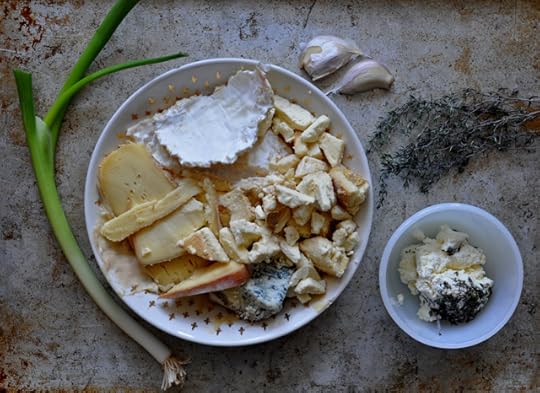
For as long as I can remember, cheese has always been a part of my holiday celebrations.
Growing up, a hunk of sharp cheddar and a wedge of Brie were must-haves leading up to Christmas, and Christmas Eve with relatives in Quebec usually meant a festive spread of nibbles centered around a raclette machine, melting slices of pungent Alpine-style cheeses over potatoes, bread, and veggies.
After scoring a cheap raclette machine of my own at my local Aldi last January, I had friends over for an evening of melted cheese, hot cider, and parlor games just before the Christmas holiday. After the revelry, a few scraps of cheese remained — and rather than tossing them into the compost, I tucked them away in the fridge to make one of my favorite thrifty, easy, cheesy recipes: fromage fort.
The name for this ingenious recycled cheese spread comes from the French for “strong cheese,” and it lives up to its name. Spiked with garlic, white wine, and herbs and spices, the pungency of whichever wedges make their way into your batch get a boost in flavor the longer you let the flavors meld in the fridge.
In addition to being delicious, fromage fort is economical, too. With a little planning and preparation, the remnants of a Christmas or New Year’s Even cheese board can be turned into a tasty spread that will stretch your celebrations well into January.
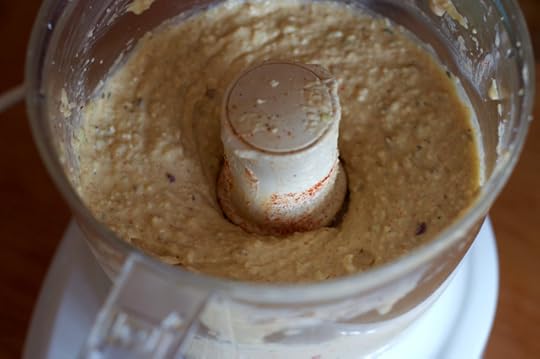
This preserving method also allows you to customize to your heart’s content: if you favor milder cheeses on your board, go easy on the garlic and spices and you’ll have a milder finished product. If you’re starting out with long-aged hard cheeses, punchy blues, or funky washed rinds, expect to make a fromage fort that will emphasize those flavors.
To make fromage fort, simply save the cheese scraps from your next party, or wait until you’ve accumulated several ends in your cheese drawer. I used a couple of savory washed-rind wheels, Lady’s Slipper from Valley Milkhouse and Humble from Parish Hill Creamery in Vermont, plus a Brie-style and a little herbed fromage blanc from Valley Milkhouse and a small hunk of Smoked Birchrun Blue from Birchrun Hills Farm here in Pennsylvania. (Keep in mind that using more than a little of a strongly flavored wedge like blue will give you something more like a blue cheese spread, so select accordingly.)
Chop your cheeses into small pieces, then bust out your food processor. Finely mince a clove or two of garlic (and maybe a scallion or a bit of shallot) in your food processor, then add your cheese, a splash of wine, and spices — like black pepper, cayenne or crushed red pepper flakes, smoked paprika, thyme, rosemary — and buzz it all up.
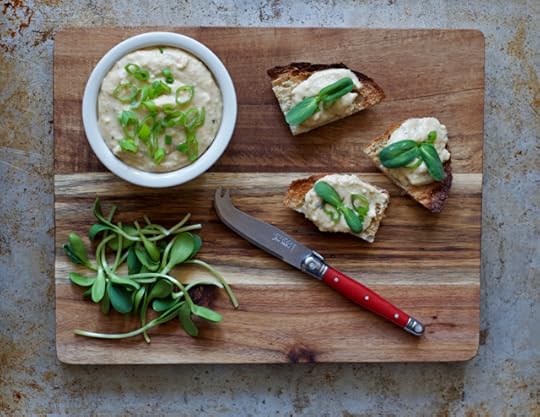
Add a dollop of cream cheese or fromage blanc (I used an herbed fromage blanc here) for a creamier texture. From here, you can serve it straightaway for a more dip-like consistency and a milder flavor, or cover and chill the mixture to let the flavors meld and strengthen. You can also freeze a well-sealed batch of fromage fort for future entertaining opportunities, too.
Serve fromage fort with veggies, crackers, bread, or crostini as-is, or spread it onto slices of bread and broil for a few minutes to make a bubbly, pungent treat to serve on the side with soup or salad.
Print
Fromage Fort (Adapted from David Leibovitz)
Ingredients
10 ounces mixed artisan cheese (you can use just about any kind, although keep the blue to no more than an ounce or so unless you want a really blue-tasting spread)
1 to 2 ounces fromage blanc or cream cheese
2 cloves garlic, peeled
1 scallion
1/4 cup white wine
Herbs and spices like black pepper, smoked paprika, cayenne, thyme, or rosemary to taste
Instructions
Chop your cheese into small pieces and set aside. Remove the green top of the scallion and set aside, cutting the white and light green parts into smaller pieces.
In a food processor, mince the garlic and white and light green parts of the scallion. Add the chunks of cheese, 1 ounce of the cream cheese, the wine, and the spices and pulse until the mixture is smooth and spreadable. If the mixture seems too thick, add the rest of the cream cheese or another splash of wine. Taste and adjust spice accordingly.
Serve immediately for a milder, dippable spread, or cover and chill for up to several days for a stronger flavor. Freeze in an airtight container for up to 6 months.
4.20
http://foodinjars.com/2018/01/make-fromage-fort/
Related Posts:
How to Make Homemade Maple Cream
Hot Pepper Hoagie Relish
Mastery Challenge: Apple-Quince Fruit Cheese
December 25, 2017
Submit your December Mastery Challenge Projects!
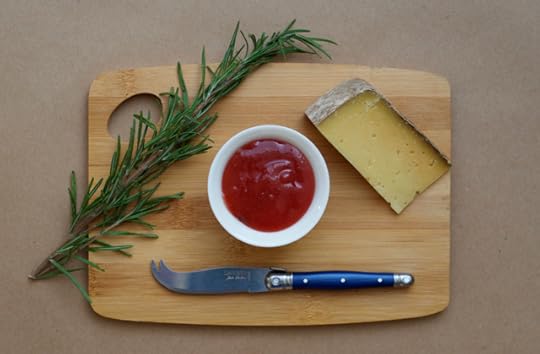
Hey folks! I’m a little late with this post, but if you completed the December Mastery Challenge task (fruit butters!), you can use this form to submit your projects!
Loading…
Related Posts:
Check the recipe index for more tasty preserves!
December 22, 2017
Guest Post: Cranberry Blueberry Compote from Heather Francis
Today’s guest post is from adventurer and home canner Heather Francis. She is originally from Nova Scotia, Canada but has lived and worked on the ocean for over a decade. A professional cook who’s worked on both land and sea, these days you’ll find her in the galley of Kate, the Newport 41’ sloop she and her Aussie partner, Steve, have been sailing since 2008. They are currently looking for wind in the Philippines. Follow their adventures on Yacht Kate.
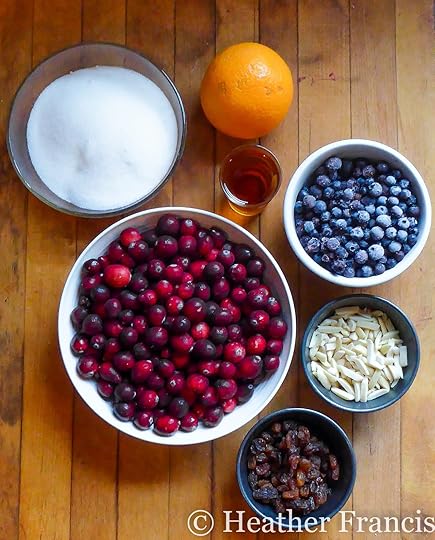
I hate store-bought versions of cranberry sauce, you know the ones. They slide out of the can with that sickening “slurp” sound that reminds you of feeding the cat in the morning and stand erect on the plate, wobbling. Or they come in a little jar, have a uniform smooth texture and so much sugar in them they should really be labelled “Cranberry Jam.”
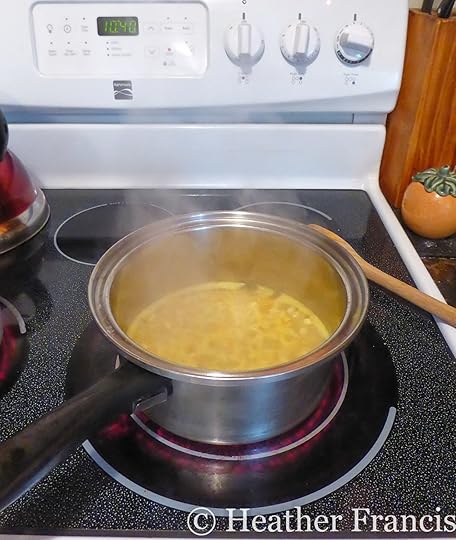
The cranberry sauce that I like is slightly tart and full of fruit, ready to burst on your tongue. It is all about the cranberries, with just hints of other flavours to dress it up for a special occasion. Ideally, I would make it just as I am about to serve it with our holiday feast, and usually there is only just enough for leftovers on Boxing Day.
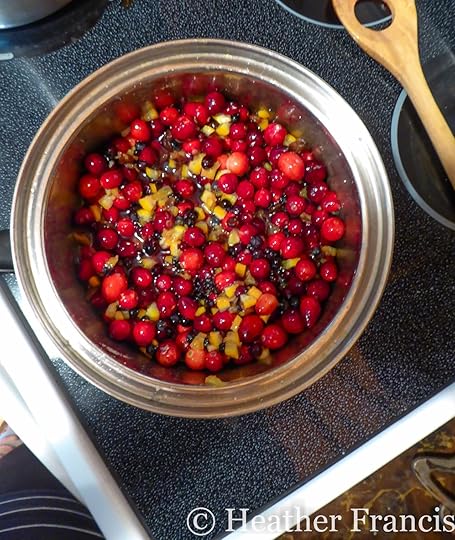
However, I have spent the last decade sailing in the tropics, not a place where cranberries grow, let alone get shipped. So our holiday roasted chicken (they also don’t grow turkeys in these parts) have been accompanied by a mango chutney. Not at all a bad stand in but not quite what I crave this time a year.
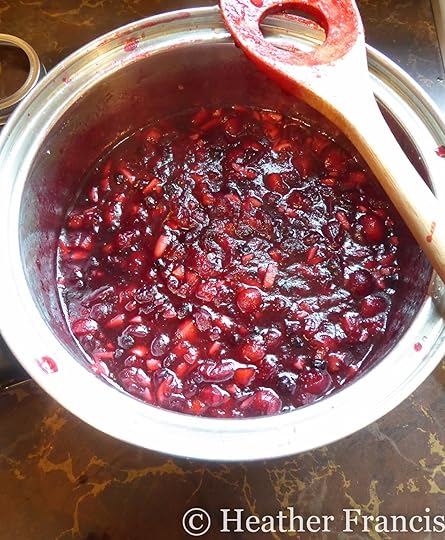
This fall, after five long years, I was lucky enough to make a trip back to Nova Scotia. Not only did I get a chance to catch up with family, but I spent some time at my Mother’s stove making a few batches of seasonal preserves.
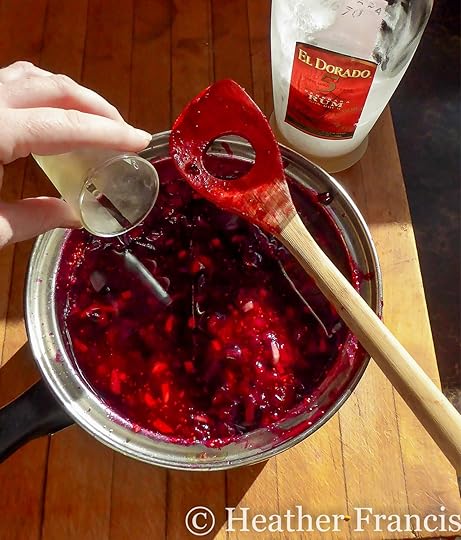
Nova Scotia is the “Wild Blueberry Capital of the World” and this year was a bumper crop that lasted well into a very warm September. Two rounds of jam, a few pies and a traditional Blueberry Grunt and the freezer was still overflowing. Then October rolled around, and the first cranberries hit the grocery stores. I jumped at the opportunity to put two of my favourite berries in the same jar.
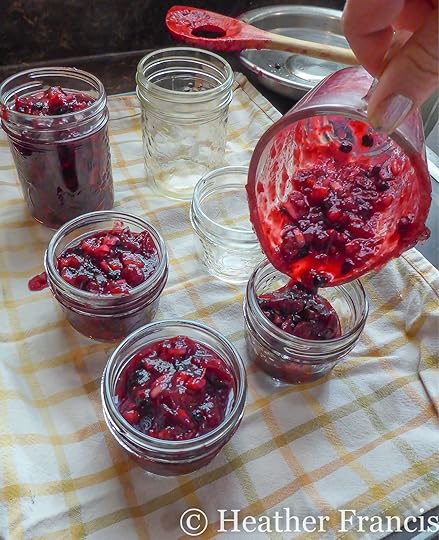
Ready in less than half an hour this compote is a dressed-up version of the classic cranberry sauce but is simple to put together. You can use fresh or frozen berries and have a light hand with the sugar since cranberries always set so well. I like using the petite 4 oz. jars, they make for a nice gift and are a little easier to fit in your luggage. The addition of almonds and a hefty splash of rum (I am a sailor!) make it feel special enough to add to a cheese board.
I won’t be heading home for the holidays this year, but I will be enjoying a little taste of Nova Scotia with my festive feast in the Philippines. I hope you enjoy it too.
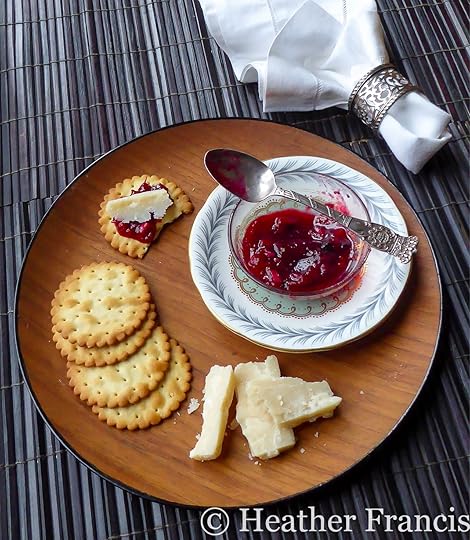
Print
Cranberry Blueberry Compote
Ingredients
1 Large Orange
2 Cups Water
3 Cups Fresh Cranberries, or 1-12oz bag
1 Cup Wild Blueberries, can be frozen
1 Cup Sugar
½ Cup Raisins
½ Cup Slivered Almonds
½ Cup Good Rum
Instructions
Finely dice the orange, removing any seeds but including the rind. Add orange, any juice and water to a medium heat and bring to a boil and cook until almost all the water has boiled off.
Add the cranberries, blueberries, sugar and raisins and bring to a boil. Turn down and simmer for 15- 20 minutes and cranberries have all popped.
Add the slivered almonds and cook another 5 minutes.
Remove from heat, add rum and stir to combine. Ladle into sterilized jars, wipe rims and place on lids. Process in a water bath for 15 minutes.
4.20
http://foodinjars.com/2017/12/guest-post-cranberry-blueberry-compote-heather-francis/
Related Posts:
Guest Post: Pink and Yellow Pickled Eggs from Heather Francis
Guest Post: Sailboat Canning and Mango Chutney from Heather Francis
Canning at The Kitchen Potager on November 12



